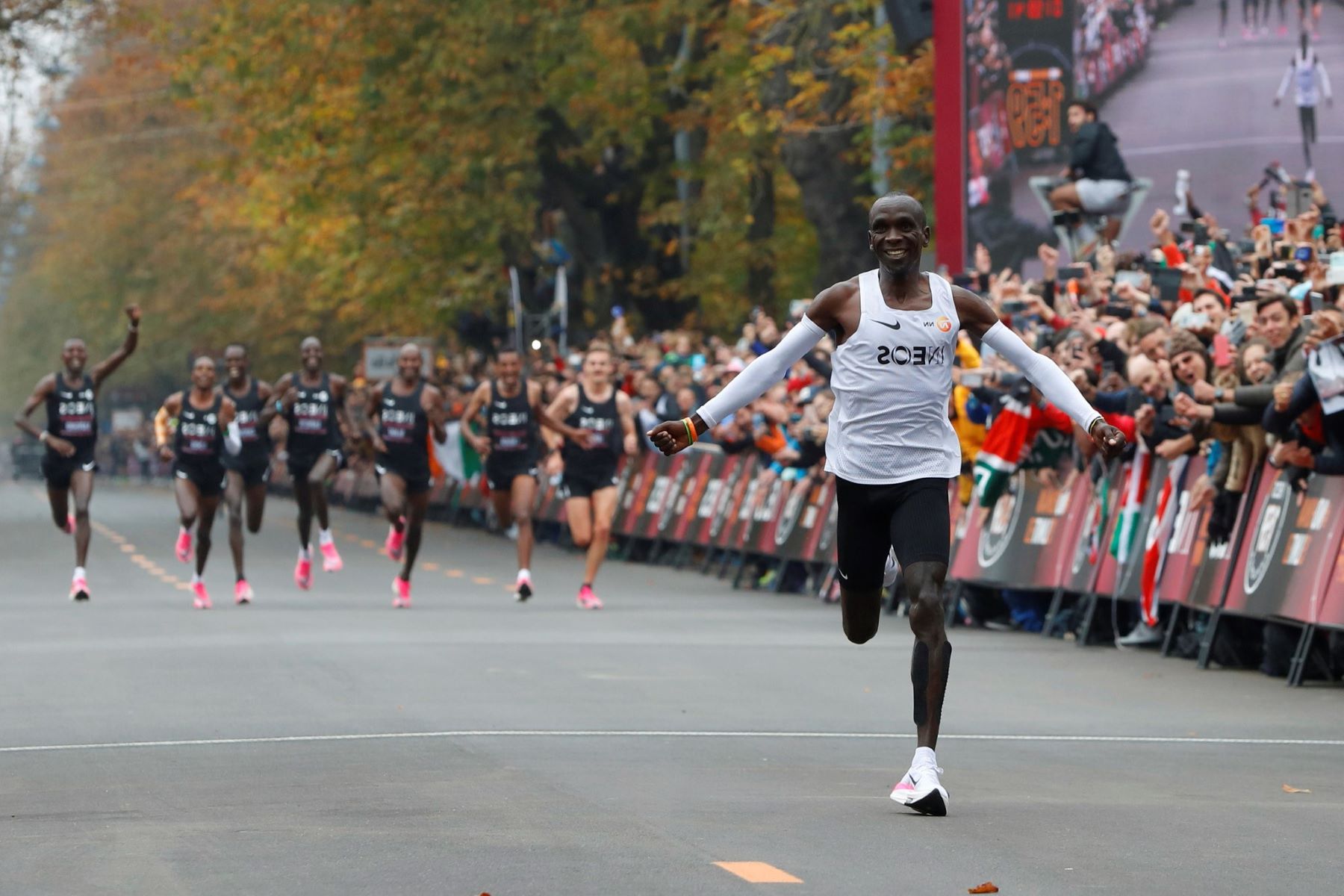Home>Training & Techniques>Cross-Training>The Impact Of CrossFit On Marathon Training


Cross-Training
The Impact Of CrossFit On Marathon Training
Published: February 20, 2024
Discover the benefits of incorporating CrossFit into your marathon training routine. Learn how cross-training can enhance your performance and prevent injury.
(Many of the links in this article redirect to a specific reviewed product. Your purchase of these products through affiliate links helps to generate commission for Therunningadvisor.com, at no extra cost. Learn more)
Table of Contents
Introduction
CrossFit and marathon training are two distinct fitness disciplines that have gained widespread popularity in recent years. CrossFit, known for its high-intensity functional movements, and marathon training, characterized by long-distance running, may seem like polar opposites at first glance. However, an increasing number of athletes and fitness enthusiasts are recognizing the potential benefits of integrating CrossFit into their marathon training regimens.
The fusion of CrossFit and marathon training represents a paradigm shift in the traditional approach to endurance and strength conditioning. While marathon training primarily focuses on building aerobic endurance and muscular stamina through running, CrossFit emphasizes a diverse range of functional movements, including weightlifting, bodyweight exercises, and cardiovascular activities. This unique combination offers a holistic approach to fitness, targeting various aspects of physical performance and overall well-being.
As individuals seek to optimize their athletic performance and overall fitness, the integration of CrossFit into marathon training has become a subject of great interest and debate. Proponents argue that CrossFit can enhance an athlete's strength, power, and agility, thereby improving their overall performance and reducing the risk of injury during marathon training. Conversely, skeptics raise concerns about the potential for overtraining, muscle fatigue, and the risk of injury associated with the high-intensity nature of CrossFit workouts.
In this article, we will delve into the impact of CrossFit on marathon training, exploring the potential benefits and drawbacks of incorporating CrossFit into traditional marathon training programs. Additionally, we will examine real-life case studies of athletes who have successfully integrated CrossFit into their marathon training routines, shedding light on the practical implications and outcomes of this cross-training approach. Ultimately, this exploration aims to provide valuable insights for individuals seeking to strike the right balance between CrossFit and marathon training, optimizing their preparation for the grueling demands of long-distance running events.
The Benefits of CrossFit for Marathon Training
CrossFit offers a myriad of advantages for individuals engaged in marathon training, encompassing physical, mental, and performance-related benefits. Here are the key advantages of incorporating CrossFit into marathon training:
-
Enhanced Strength and Power: CrossFit workouts are designed to improve overall strength and power through a combination of weightlifting, bodyweight exercises, and functional movements. These strength-building activities can significantly enhance an athlete's muscular endurance, enabling them to maintain proper running form and sustain optimal performance throughout the entirety of a marathon.
-
Improved Core Stability and Balance: The functional movements in CrossFit engage the core muscles, promoting enhanced stability and balance. This is particularly beneficial for marathon runners, as a strong and stable core can help prevent injuries and maintain proper posture during long-distance running, ultimately contributing to improved running efficiency and reduced fatigue.
-
Diverse Range of Movements: CrossFit incorporates a wide variety of movements, including running, rowing, jumping, and lifting. This diversity helps to develop a well-rounded level of fitness, ensuring that marathon runners are not only proficient in running but also adept at handling various physical challenges encountered during a race.
-
Increased Anaerobic Capacity: CrossFit workouts often involve high-intensity intervals and short bursts of maximal effort, which can effectively improve an athlete's anaerobic capacity. This can be advantageous during a marathon, where brief surges of speed or the ability to conquer challenging terrains can make a significant difference in overall race performance.
-
Injury Prevention and Rehabilitation: The strength and conditioning aspects of CrossFit can aid in injury prevention and rehabilitation for marathon runners. By targeting muscle imbalances and weaknesses, CrossFit can help address common running-related injuries and mitigate the risk of overuse injuries, thereby promoting long-term athletic longevity.
-
Mental Toughness and Resilience: CrossFit workouts are renowned for their demanding nature, fostering mental toughness and resilience in athletes. This mental fortitude can be invaluable during the arduous and mentally taxing stages of a marathon, enabling runners to push through fatigue and discomfort with greater determination and focus.
In summary, the integration of CrossFit into marathon training can yield a multitude of benefits, ranging from enhanced physical strength and endurance to improved mental fortitude and injury resilience. By leveraging the diverse training modalities offered by CrossFit, marathon runners can elevate their overall performance and readiness for the challenges presented by long-distance running events.
The Drawbacks of CrossFit for Marathon Training
While the integration of CrossFit into marathon training presents numerous benefits, it is essential to acknowledge the potential drawbacks and considerations associated with this cross-training approach. Understanding the limitations and challenges of incorporating CrossFit into marathon training is crucial for athletes and fitness enthusiasts seeking to strike a balanced and sustainable approach to their overall fitness and performance goals.
Overemphasis on High-Intensity Workouts
One of the primary drawbacks of CrossFit for marathon training lies in the potential overemphasis on high-intensity workouts. CrossFit sessions often involve vigorous, high-impact exercises that can lead to increased muscle fatigue and overall physical exhaustion. For marathon runners, who already engage in extensive endurance training, the additional strain from intense CrossFit workouts may elevate the risk of overtraining, potentially compromising the body's ability to recover adequately between running sessions.
Risk of Muscular Imbalance and Overuse Injuries
CrossFit's emphasis on varied functional movements and strength training, while beneficial in many aspects, can also pose a risk of muscular imbalances and overuse injuries for marathon runners. The repetitive nature of certain CrossFit exercises, combined with the demands of marathon training, may lead to overworked muscles and imbalances in the body's musculature. This imbalance can potentially increase the susceptibility to injuries, particularly in areas that are already under significant stress due to the repetitive nature of running.
Time and Energy Allocation
Integrating CrossFit into marathon training requires careful consideration of time and energy allocation. Marathon training already demands a substantial time commitment, with long runs, recovery sessions, and cross-training activities. Adding CrossFit workouts to an already rigorous training schedule may lead to challenges in balancing recovery time, potentially impacting the body's ability to recuperate adequately between training sessions.
Potential for Burnout and Fatigue
The combination of intense CrossFit workouts and marathon training can potentially contribute to physical and mental burnout. The cumulative impact of high-intensity training from both disciplines may lead to excessive fatigue, diminishing the athlete's overall performance and recovery capacity. Additionally, the mental strain of consistently engaging in demanding workouts without sufficient rest periods can erode motivation and enthusiasm, ultimately hindering the athlete's long-term progress and well-being.
Risk of Overtraining Syndrome
Overtraining syndrome, characterized by persistent fatigue, decreased performance, and potential health issues, is a significant concern when integrating CrossFit into marathon training. The cumulative stress from both high-intensity CrossFit workouts and the demands of marathon training can push the body beyond its recovery threshold, leading to a state of overtraining. This can have detrimental effects on an athlete's physical and mental health, necessitating a delicate balance between training intensity and recovery periods.
In summary, while CrossFit offers a diverse array of benefits for marathon training, it is imperative to recognize and address the potential drawbacks and challenges associated with this cross-training approach. By carefully considering these limitations and implementing a well-structured training plan, athletes can mitigate the risks and optimize the synergistic benefits of integrating CrossFit into their marathon training regimen.
Incorporating CrossFit into Marathon Training Plans
Integrating CrossFit into marathon training plans requires a thoughtful and strategic approach to ensure that the benefits of both disciplines are maximized while mitigating potential drawbacks. By carefully structuring the incorporation of CrossFit workouts into a marathon training regimen, athletes can optimize their overall fitness, performance, and resilience for the demands of long-distance running events.
Read more: 25 Tips For Effective Marathon Training
Periodization and Balance
A key consideration when incorporating CrossFit into marathon training plans is the concept of periodization. This involves strategically dividing the training program into distinct phases, each emphasizing different aspects of fitness and performance. By integrating CrossFit workouts during specific phases of the training cycle, athletes can capitalize on the strength and power gains from CrossFit while maintaining a focus on endurance and aerobic conditioning essential for marathon success. This balanced approach ensures that the intensity and volume of CrossFit workouts align with the overarching goals of the marathon training plan, preventing excessive strain and fatigue.
Strategic Scheduling and Recovery
Careful scheduling of CrossFit sessions within the marathon training plan is essential to optimize performance and recovery. Integrating CrossFit workouts on days that complement the overall training schedule, such as incorporating strength-focused sessions on lower-intensity running days or during recovery periods, can help athletes achieve a harmonious balance between strength conditioning and endurance training. Additionally, prioritizing adequate recovery time between CrossFit and running sessions is crucial to prevent overtraining and promote optimal adaptation to the combined training stimuli.
Targeted CrossFit Modalities
Tailoring the selection of CrossFit modalities to complement marathon training goals is paramount. Emphasizing movements and exercises that enhance muscular endurance, core stability, and power, such as kettlebell swings, box jumps, and bodyweight exercises, can directly benefit marathon performance. Furthermore, integrating specific CrossFit workouts that simulate the demands of long-distance running, such as interval training and plyometric exercises, can effectively bridge the gap between CrossFit and marathon training, fostering a synergistic adaptation to varied physical challenges.
Individualized Approach and Monitoring
Recognizing the individualized nature of training adaptations, athletes should closely monitor their response to the integrated CrossFit and marathon training plan. This involves assessing performance metrics, recovery markers, and overall well-being to gauge the effectiveness of the combined training approach. By maintaining flexibility in the training plan and making adjustments based on individual responses, athletes can optimize the integration of CrossFit into their marathon training regimen, ensuring that the combined training modalities align with their unique physiological and performance needs.
In essence, incorporating CrossFit into marathon training plans necessitates a strategic and individualized approach that emphasizes periodization, balance, targeted modalities, and meticulous monitoring. By integrating CrossFit in a synergistic manner that complements the specific demands of marathon training, athletes can harness the diverse benefits of both disciplines, ultimately enhancing their overall readiness and performance for the rigors of long-distance running events.
Case Studies: Athletes Who Have Used CrossFit for Marathon Training
Sarah's Success Story
Sarah, an avid marathon runner, sought to elevate her performance and resilience for an upcoming marathon. Embracing the concept of cross-training, she integrated CrossFit into her marathon training regimen under the guidance of a certified coach. By strategically incorporating CrossFit workouts focused on strength, core stability, and anaerobic conditioning, Sarah experienced remarkable improvements in her overall performance. The enhanced strength and power gained from CrossFit translated into more efficient running mechanics and reduced muscular fatigue during long training runs. Sarah's successful integration of CrossFit into her marathon training plan not only led to a significant improvement in her race times but also contributed to a notable reduction in running-related injuries, highlighting the synergistic benefits of combining these two diverse training modalities.
James' Journey to Resilience
James, a seasoned marathon enthusiast, faced the challenge of overcoming a plateau in his race performance and recurrent injuries. Eager to revitalize his training approach, he incorporated CrossFit into his marathon preparation, focusing on targeted strength and stability exercises. By integrating CrossFit workouts that emphasized core strength, balance, and injury prevention, James experienced a transformative shift in his running capabilities. The enhanced core stability and muscular resilience gained from CrossFit not only bolstered his endurance during long training runs but also mitigated the recurrence of previous running-related injuries. James' journey exemplifies the profound impact of integrating CrossFit into marathon training, showcasing the potential for enhanced resilience and injury mitigation through a well-structured cross-training approach.
Maria's Multifaceted Training Strategy
Maria, a dedicated marathon runner with a passion for diverse fitness modalities, embraced a multifaceted training strategy that integrated CrossFit into her marathon preparation. By strategically incorporating CrossFit workouts that encompassed a wide range of functional movements, cardiovascular conditioning, and strength training, Maria achieved a holistic level of fitness that transcended traditional marathon training. The diverse range of movements and training modalities offered by CrossFit not only enhanced Maria's overall physical preparedness for marathon events but also fostered a resilient and adaptable athletic profile. Maria's experience underscores the versatility and comprehensive benefits of integrating CrossFit into marathon training, showcasing the potential for a well-rounded and resilient approach to long-distance running endeavors.
In these compelling case studies, the successful integration of CrossFit into marathon training plans has demonstrated the transformative impact of cross-training on athletes' performance, resilience, and injury mitigation. These real-life examples underscore the potential for synergistic adaptations and holistic fitness enhancements that arise from strategically combining the diverse training modalities of CrossFit with the demands of marathon preparation.
Conclusion: Finding the Right Balance for Your Training
Achieving the optimal balance between CrossFit and marathon training is a dynamic and personalized endeavor that hinges on a nuanced understanding of individual fitness goals, physiological adaptations, and performance requirements. The integration of CrossFit into marathon training represents a paradigm shift in traditional endurance conditioning, offering a multifaceted approach to physical preparedness and athletic resilience. As athletes navigate the complexities of combining these distinct disciplines, the pursuit of equilibrium becomes paramount in maximizing the synergistic benefits while mitigating potential drawbacks.
Finding the right balance necessitates a deliberate and individualized approach that acknowledges the unique physiological responses and training adaptations of each athlete. By embracing the principles of periodization, athletes can strategically allocate the intensity and volume of CrossFit workouts within the broader context of their marathon training plan, ensuring that strength and power gains from CrossFit harmonize with the demands of long-distance running. This deliberate structuring of training phases facilitates a balanced progression, preventing excessive strain and fatigue while optimizing the cumulative benefits of cross-training.
Moreover, the strategic scheduling and recovery management of CrossFit sessions within the marathon training plan play a pivotal role in achieving equilibrium. By aligning CrossFit workouts with the overall training schedule and prioritizing adequate recovery periods, athletes can safeguard against overtraining and promote optimal adaptation to the combined training stimuli. This deliberate orchestration of training stimuli and recovery intervals fosters a sustainable and harmonious integration of CrossFit into marathon training, safeguarding against burnout and fatigue.
Furthermore, the individualized selection of CrossFit modalities tailored to complement marathon training goals is instrumental in achieving the desired balance. By emphasizing movements and exercises that enhance muscular endurance, core stability, and power, athletes can synergistically bridge the gap between CrossFit and marathon training, fostering a holistic and resilient athletic profile. This targeted approach ensures that the integration of CrossFit aligns with the specific demands of marathon preparation, optimizing the multifaceted benefits of cross-training.
In essence, the pursuit of balance in integrating CrossFit into marathon training transcends a mere juxtaposition of training modalities; it embodies a strategic and adaptive synergy that harmonizes the diverse facets of athletic conditioning. By embracing a personalized and deliberate approach that encompasses periodization, strategic scheduling, targeted modalities, and meticulous monitoring, athletes can navigate the complexities of cross-training, ultimately finding the optimal equilibrium that elevates their readiness and performance for the rigors of long-distance running events.












